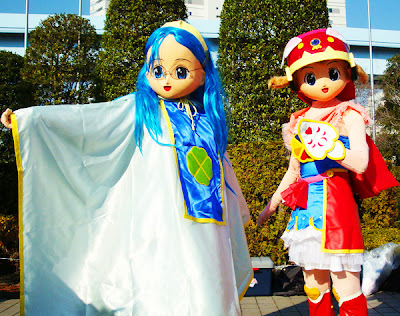Kigurumi (着ぐるみ) is a term for masked full body costuming in Japan. Costumes range from animals to "giant" robots to cartoon characters. Most people are familiar with kigurumi through performers at major theme parks such as a full Mickey Mouse costume at Disney World. In Japan there are hobbyists who perform kigurumi for fun at costuming and related events such as Wonder Festival in Chiba. Held twice a year, Wonder Festival is Japan's largest amateur figurine & sculpting convention. With the focus of the event being on amateur craftsmanship, costuming has become a growing side feature of the convention. Animegao (アニメ顔), literally animation face, is a subset of kigurumi where full body costumes of Japanese animation and game characters are worn, although the term animegao is not preferred by the performers themselves. Note performer is used, not costumer. This is because, like the Mickey Mouse performer at Disney World, amateur performers dressed as anime characters never speak when in costume and act the part of their character through exaggerated body movements when engaged by a spectator. Most costumes are of female characters and the majority of people involved in the hobby are men. But I saw two kigurumi costumers with their masks off who were women while at Wonder Festival. Those men who I have talked to, despite wearing female costumes, are heterosexual and don't see the wearing of the mask as a way of cross dressing while remaining anonymous. This is very believable since more men openly dressed as female characters without a mask than there were those in kigurumi. The kigurumi hobbyists viewed the costumes as being as authentic to a figurine or character as a costume can be and enjoy the performance side of it since as a man, they can bring out the desired feminine attributes of the character in only the way a male can much like a Kabuki actor.
This is blog is a student assignment for a university visual anthropology course. The blog shall be terminated upon the end of the course in April 2012. Permission has been obtained from individuals before the posting any images of persons. In the case of more general images, great consideration has been given to individual privacy and respect in these circumstances. However, should there be any concerns please contact me and I shall move to quickly resolve them including image removal.
Wednesday, February 22, 2012
Izanagi Okami shrine in Ryogoku
The deity Izanagi has been worshiped since at least the beginning of the 8th Century C.E. and gained popularity during the Edo Period. Izanagi is a deity of fertility, rice, agriculture in general, blacksmiths, industry, and foxes and can be portrayed as a man, woman, or androgynous suggesting that the Izanagi may be a combination of several deities. Izanagi has remained in favor in modern Japan by having a connection with business and industry. Izanagi shrines are typically easy to identify since images of foxes are usually present. These kitsune are messengers of Izanagi. This positive representation of foxes intrigues me since many rural superstitions exist, particularly in northern regions, portraying foxes as mischievous supernatural creatures that cause all any number of problems including possession. Even up until the 20th century families that had been labeled "fox owning" families were persecuted by their villages.
Thursday, February 9, 2012
China Town
Sumo Introductions, Music?
The introductions caught my eye because they are rather musical in nature. The tones and general rhythm of each introduction follow a precise patern, but small variations can be heard amongst each individual. Most examples of traditional Japanese music place focus on the voice as the primary instrument and this often extends to forms of narration such as the Tayu of Bunraku plays, so it is not too surprising to find the voice used in such a musical manner.
Subscribe to:
Comments (Atom)







